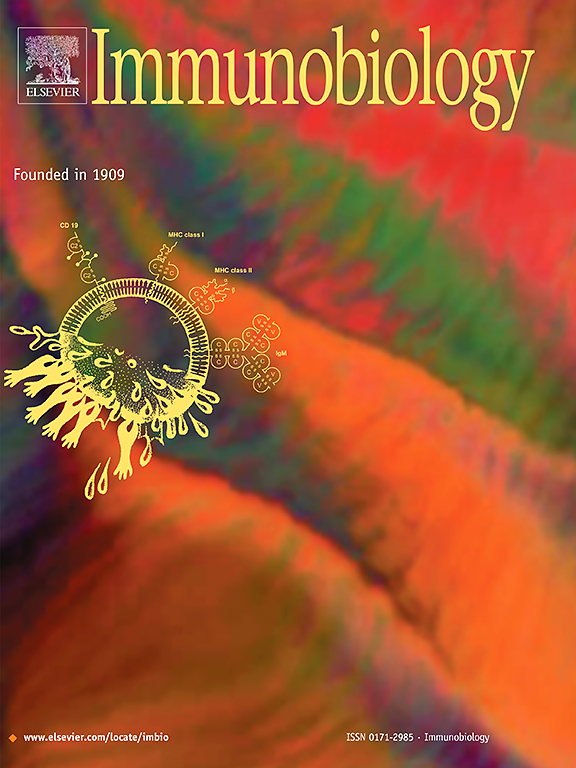Kasumi-1 exosome plays a major T-cell immune evasion role in TP53-type acute leukemia
IF 2.3
4区 医学
Q3 IMMUNOLOGY
引用次数: 0
Abstract
Background
The treatment and prognosis for TP53-mutant acute leukemia (AL) are notably unfavorable. Tumor-derived exosomes are participating in tumorigenesis and immunomodulation. Our objective was to characterize the exosome-mediated immune landscape in TP53-mutant AL.
Methods
Four TP53 AL cell lines were selected for study. RT-qPCR and western blot were used to determine the PD-L1 and TP53. AL exosomes (AL-exos) were co-cultured with PBMC. Flow cytometry was used to determine immune cell and PD-1 expression. Transmission electron microscopy and western blot determination of MOLM-13 and Kasumi-1 exosome surface markers HSP70, CD9, CD63, and CD81. Subsequently, miRNA sequencing was performed.
Results
In TP53 AL cell lines, PD-L1 protein, and mRNA expression increased sequentially in MOLM-13, Kasumi-1, Molt-4, and KG-1 cells. Notably, MOLM-13 and Kasumi-1 exhibited the highest TP53 expression. Flow cytometry results indicated that Kasumi-1-exosomes had a more pronounced effect on immune cells, resulting in a significant reduction in CD8+ T cell populations and a notable increase in Tregs. Notably, its PD-1 expression was significantly elevated. miRNA analysis showed that the DEGs were primarily enriched in signaling transduction and endocytosis pathways.
Conclusion
Kasumi-1-exos promote DNA damage and PD-L1 enrichment through clathrin-mediated plasma membrane fusion, which ultimately leads to AL immune escape characterized primarily by decreased CD8+ T cell expression and increased Treg expression.
Kasumi-1外泌体在tp53型急性白血病中起主要的t细胞免疫逃避作用
背景:tp53突变型急性白血病(AL)的治疗和预后非常不利。肿瘤源性外泌体参与肿瘤发生和免疫调节。我们的目的是表征外泌体介导的TP53突变体的免疫景观。方法选择4个TP53 AL细胞系进行研究。采用RT-qPCR和western blot检测PD-L1和TP53。AL外泌体与PBMC共培养。流式细胞术检测免疫细胞和PD-1的表达。透射电镜和western blot检测MOLM-13和Kasumi-1外泌体表面标记物HSP70、CD9、CD63和CD81。随后,进行miRNA测序。结果在TP53 AL细胞系中,MOLM-13、Kasumi-1、Molt-4和KG-1细胞中PD-L1蛋白和mRNA的表达量依次升高。值得注意的是,MOLM-13和Kasumi-1的TP53表达量最高。流式细胞术结果表明,kasumi -1外泌体对免疫细胞有更明显的作用,导致CD8+ T细胞群显著减少,Tregs显著增加。值得注意的是,PD-1表达明显升高。miRNA分析显示,deg主要富集于信号转导和内吞途径。结论kasumi -1-exos通过网格蛋白介导的质膜融合促进DNA损伤和PD-L1富集,最终导致AL免疫逃逸,主要表现为CD8+ T细胞表达降低和Treg表达增加。
本文章由计算机程序翻译,如有差异,请以英文原文为准。
求助全文
约1分钟内获得全文
求助全文
来源期刊

Immunobiology
医学-免疫学
CiteScore
5.00
自引率
3.60%
发文量
108
审稿时长
55 days
期刊介绍:
Immunobiology is a peer-reviewed journal that publishes highly innovative research approaches for a wide range of immunological subjects, including
• Innate Immunity,
• Adaptive Immunity,
• Complement Biology,
• Macrophage and Dendritic Cell Biology,
• Parasite Immunology,
• Tumour Immunology,
• Clinical Immunology,
• Immunogenetics,
• Immunotherapy and
• Immunopathology of infectious, allergic and autoimmune disease.
 求助内容:
求助内容: 应助结果提醒方式:
应助结果提醒方式:


